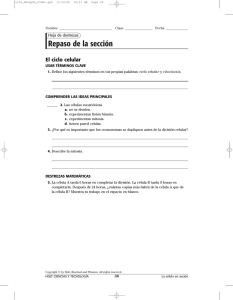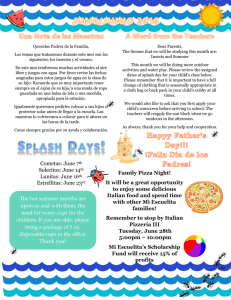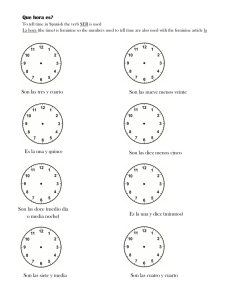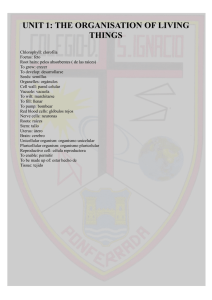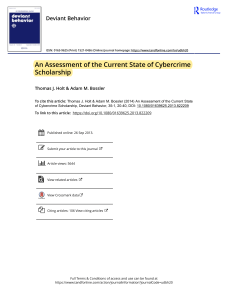Repaso del capítulo
Anuncio
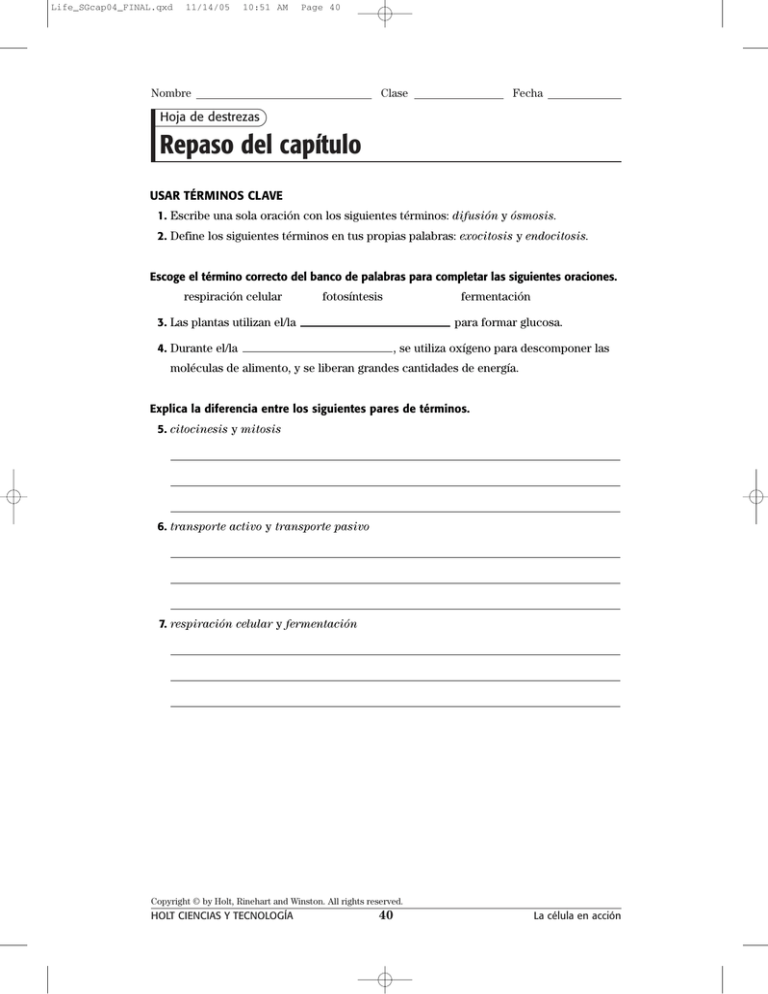
Life_SGcap04_FINAL.qxd 11/14/05 10:51 AM Page 40 Nombre Clase Fecha Hoja de destrezas Repaso del capítulo USAR TÉRMINOS CLAVE 1. Escribe una sola oración con los siguientes términos: difusión y ósmosis. 2. Define los siguientes términos en tus propias palabras: exocitosis y endocitosis. Escoge el término correcto del banco de palabras para completar las siguientes oraciones. respiración celular fotosíntesis fermentación 3. Las plantas utilizan el/la para formar glucosa. 4. Durante el/la , se utiliza oxígeno para descomponer las moléculas de alimento, y se liberan grandes cantidades de energía. Explica la diferencia entre los siguientes pares de términos. 5. citocinesis y mitosis 6. transporte activo y transporte pasivo 7. respiración celular y fermentación Copyright © by Holt, Rinehart and Winston. All rights reserved. HOLT CIENCIAS Y TECNOLOGÍA 40 La célula en acción Life_SGcap04_FINAL.qxd 11/14/05 10:51 AM Page 41 Nombre Clase Fecha Repaso del capítulo (continuación) COMPRENDER LAS IDEAS PRINCIPALES Opción múltiple ______ 8. El proceso por el cual las partículas atraviesan una membrana desde una región de baja concentración a una de alta concentración se denomina a. difusión. c. transporte activo. b. transporte pasivo. d. fermentación. ______ 9. ¿Qué resulta de la mitosis y la citocinesis? a. dos células idénticas c. cloroplastos b. dos núcleos d. dos células distintas ______ 10. Antes de que la energía contenida en el alimento pueda ser utilizada por una célula, la energía debe transferirse primero a las moléculas de a. proteínas. c. ADN. b. carbohidratos. d. ATP. ______ 11. ¿Cuál de los siguientes tipos de células formaría una placa celular durante el ciclo celular? a. una célula humana c. una célula vegetal b. una célula procariótica d. Todas las anteriores Respuesta breve 12. ¿Son la exocitosis y la endocitosis ejemplos de transporte activo o pasivo? Explica tu respuesta. 13. Menciona las estructuras celulares necesarias para la fotosíntesis y las necesarias para la respiración celular. 14. Describe las tres etapas del ciclo celular de una célula eucariótica. Copyright © by Holt, Rinehart and Winston. All rights reserved. HOLT CIENCIAS Y TECNOLOGÍA 41 La célula en acción Life_SGcap04_FINAL.qxd 11/14/05 10:51 AM Page 42 Nombre Clase Fecha Repaso del capítulo (continuación) RAZONAMIENTO CRÍTICO 15. Mapa de conceptos Haz un mapa de conceptos con los siguientes términos: duplicación de cromosomas, citocinesis, procariote, mitosis, ciclo celular, fisión binaria y eucariote. Copyright © by Holt, Rinehart and Winston. All rights reserved. HOLT CIENCIAS Y TECNOLOGÍA 42 La célula en acción Life_SGcap04_FINAL.qxd 11/14/05 10:51 AM Page 43 Nombre Clase Fecha Repaso del capítulo (continuación) 16. Inferir ¿A cuál de las plantas ilustradas a continuación se le dio agua mezclada con sal, y a cuál se le dio agua pura? Explica cómo lo sabes, y asegúrate de usar la palabra ósmosis en tu respuesta. 17. Identificar relaciones ¿Por qué necesitarían más alimento tus células musculares en ausencia de oxígeno que en presencia de abundante oxígeno? 18. Aplicar conceptos Una célula madre posee 10 cromosomas. a. ¿Experimentará la célula fisión binaria o mitosis y citocinesis para producir nuevas células? b. ¿Cuántos cromosomas tendrá cada célula nueva después de la división de la célula madre? Copyright © by Holt, Rinehart and Winston. All rights reserved. HOLT CIENCIAS Y TECNOLOGÍA 43 La célula en acción Life_SGcap04_FINAL.qxd 11/14/05 10:51 AM Page 44 Nombre Clase Fecha Repaso del capítulo (continuación) INTERPRETAR GRÁFICAS La siguiente ilustración muestra una célula. Consúltala para contestar las siguientes preguntas. 19. ¿Es la célula procariótica o eucariótica? 20. ¿En qué etapa del ciclo celular se encuentra esta célula? 21. ¿Cuántas cromátidas hay? ¿Cuántos pares de cromosomas homólogos hay? 22. ¿Cuántos cromosomas habrá en cada célula nueva después de la división celular? Copyright © by Holt, Rinehart and Winston. All rights reserved. HOLT CIENCIAS Y TECNOLOGÍA 44 La célula en acción ANSWER KEY 7. Sample answer: Animals such as birds, 6. Active transport requires the cell to insects, and mammals would be good on the island. Plants must be on the island in order to provide a source of food for the animals. 7. SECTION: THE CELL CYCLE 1. Sample answer: The cell cycle 2. 3. 4. 5. 6. 7. 8. describes all of the stages a cell goes through in its life. Cytokinesis is the last stage of cell reproduction when a cell’s cytoplasm is split between the two new cells. C Chromosomes need to be copied so that the two new cells have the same genetic material as the parent cell. Sample answer: Before mitosis begins, the chromosomes are copied. In phase 1, the nuclear membrane dissolves, and the chromosomes condense. In phase 2, the chromosomes line up along the equator of the cell, and homologous chromosomes pair up. In phase 3, the chromatids move to opposite sides of the cell. In phase 4, a nuclear membrane forms around the chromosomes, and the chromosomes unwind. 8 If cytokinesis occurred without mitosis, each cell would only have half of the parent cell’s genetic material or less. Mitosis ensures that each new cell receives a copy of each chromosome, and hence, an exact copy of the parent cell’s genetic material. The processes of animal and plant cells are different because plant cells have cell walls. Cytokinesis is different in plant cells, but all other stages of mitosis are essentially the same as they are in animal cells. 8. 9. 10. 11. 12. 13. 14. 15. 16. Chapter Review 1. Sample answer: Osmosis is the diffu- 2. 3. 4. 5. sion of water through a semipermeable membrane. Sample answer: Exocytosis is the process cells use to remove large particles; endocytosis is the process cells use to move large particles into a cell. photosynthesis cellular respiration Cytokinesis is the division of just the cytoplasm. Mitosis is the process in eukaryotic cells in which the nuclear material splits to form two new nuclei. 17. use energy to move substances. Passive transport does not require the cell to use any energy. Cellular respiration releases stored energy by using oxygen. Fermentation releases stored energy without using oxygen. C A D C Endocytosis and exocytosis are examples of active transport. In both processes the cell must change shape, wrap around a particle, and make other movements that require the cell to use energy. Chloroplasts are needed for photosynthesis. Cellular respiration requires mitochondria. The first stage is cell growth and copying of DNA (duplication.) The second stage is mitosis, which involves separating the duplicated chromosomes. The third stage is cytokinesis (cell division), which results in two separate, identical cells. An answer to this exercise can be found at the end of the Teacher Edition. The plant on the left was given pure water. The plant on the right was given salt water. Osmosis occurred in both plants. In the plant on the left, water moved into the plant because the concentration of water was lower in the plant than in the soil. So, the plant on the left did not wilt. In the plant on the right, the water in the plant moved into the soil, where the concentration of water was lower. The concentration of water in the soil was lower because the water contained salt. As a result, the plant on the right wilted. When there is plenty of oxygen, the cells can get energy from cellular respiration. When there is a lack of oxygen, the cell must use fermentation, which doesn’t produce as much energy. For fermentation to produce more energy, more food would be required. Copyright © by Holt, Rinehart and Winston. All rights reserved. Holt Science and Technology 93 The Cell in Action ANSWER KEY THIS IS RADIO KCEL 18. a. The cell is a eukaryotic cell and 19. 20. 21. 22. will go through mitosis and cytokinesis. Prokaryotic cells have only one chromosome. b. Each new cell will receive a copy of each chromosome, so each new cell will have 10 chromosomes. The cell is eukaryotic because it shows chromatids held together at a centromere. Prokaryotic cells do not have chromatids. The cell is in mitosis because the chromosomes have already duplicated. There are 12 chromatids. There are three pairs of homologous chromosomes. There will be six chromosomes in each new cell. Segment A: 3 Segment B: 1 Segment C: 4 Segment D: 2 Critical Thinking 1. Answers may vary. Sample answer: yes; 2. Reinforcement 3. INTO AND OUT OF THE CELL Osmosis: • particles move from an area of high concentration to an area of low concentration • water • does not require ATP 4. Passive Transport: • particles move through proteins • particles move from an area of high concentration to an area of low concentration • sugar • does not require ATP 5. When placed in fresh water, a typical cell will absorb water until it bursts. Because the concentration of water particles is higher outside the cell, water will flow into the cell by osmosis. The S.C.A.M. scientists will have to discover a way of stopping the cells’ absorption of fresh water before the cells burst. a. food b. endocytosis c. active transport d. cellular respiration e. fermentation f. passive transport g. exocytosis The salt will decrease the concentration of water in the fluid outside the cells. This will cause dehydration as water leaves the cells by osmosis. Answers may vary. Sample answer: He could destroy the cells by restricting their oxygen flow or by destroying their mitochondria. Section Quizzes Active Transport: • particles move through proteins • particles move from an area of low concentration to an area of high concentration • requires ATP SECTION: EXCHANGE WITH THE ENVIRONMENT 1. 2. 3. 4. 5. ACTIVITIES OF THE CELL 1.-4. B E G F C 6. 7. 8. 9. A D D A SECTION: CELL ENERGY 1. 2. 3. 4. C B C C 5. 6. 7. 8. E B A C SECTION: THE CELL CYCLE 5. Chloroplasts also use carbon dioxide and water to make glucose. 6. Mitochondria also give off carbon dioxide and water during cellular respiration. 1. 2. 3. 4. D C E B 5. 6. 7. 8. A B A C Copyright © by Holt, Rinehart and Winston. All rights reserved. Holt Science and Technology 94 The Cell in Action
